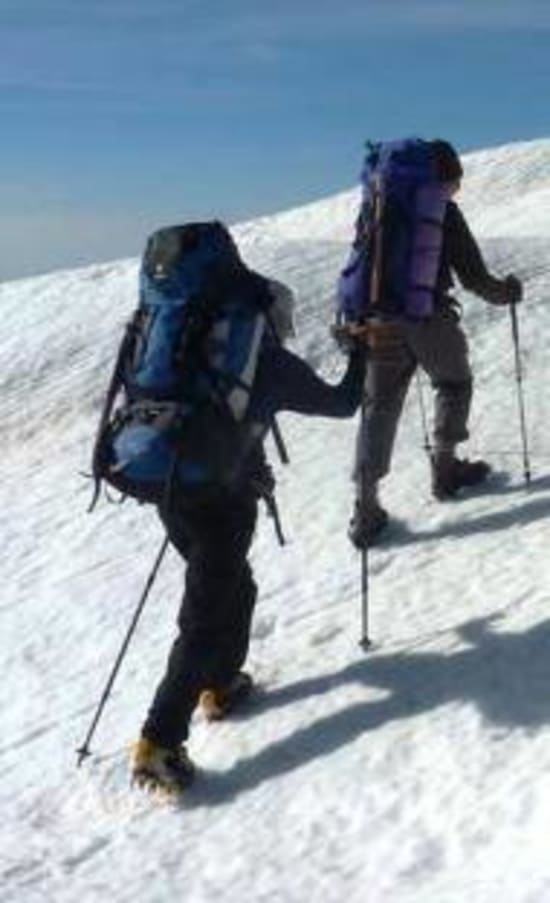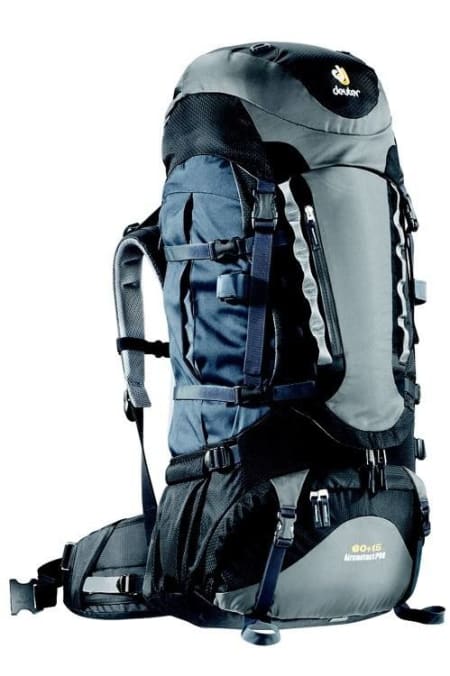We have been testing these Deuter Aircontact Pro rucksacks recently in the Sierra Nevada for our forthcoming expeditions to Bolivia's Cordillera Real and the Patagonian Icefields. But how did they perform?

Deuter Aircontact Pro rucksack
Firstly, why did we choose the Deuter Aircontact Pro rucksacks to test? Well, we like Deuter and have used some of their smaller packs successfully for many years and they have a reputable name in outdoor manufacturing. Our last sacks from Macpac failed to perform well under the heavy loads required for a Patagonian Icefield Expedition. Google research also provided much to recommend the Aircontact Pro.
Models
The Aircontact Pro is the flagship of Deuter's range. They have a variety of models (http://www.deuter.com) for various sizes. We chose the 70+15 and the 65 +15 SL, which is the womens version with modified carrying system.
The "interesting bit" of the specifications
(from the manufacturer website) The ‘pull-forward’ function makes the hip belt easy to fasten, even with even heavy loads. Breathable cushion with ventilating Aircontact technology. Durable 3D Airmesh back system overall lining wicks away warmth and moisture. 3 Height adjustable load transfer straps on the shoulder straps for precision pack positioning. 4 Contoured shoulder straps with 3D Air mesh lining. Heavy duty construction with special dual layer foams. 5 Two ergonomically formed V-shape multi-chamber aluminium stays, direct part of the load from the back to the hips. 6 When fastened, the hip fins taper upwards in a conical form. The fins are concave and ultra-padded and sit perfectly on the hips. The multi-layered, PE-stiffened foam spreads the load evenly. Heavy loads can be carried easily if the backpack and the wearer form one unit. That is where our Aircontact principle kicks in with our trekking backpacks: a body contact system with perfect stability, optimal load distribution and effective ventilation. With every movement a pump effect circulates air through the breathable Hollow chamber Aicontact cushions to provide all-round ventilation. The special bilaminate ACT construction allows the wearer to carry the backpack close to the body but still allows for extremely good ventilation. The result: 15% less perspiration than with a conventional Trekking rucksack.
How did the sack perform?

The 65+15 SL in the Sierra Nevada
We had 2 hard days trekking/easy mountaineering in the Sierra Nevada (see https://www.spanishhighs.com/articles/crossing-sierra-nevada-winter-conditions-june/). We purposely carried excess weight to bolster the pack size to more that normally necessary for a 2 day trip.
Incidentally, the additional weight included some anti-fox deterrents in case of fox attacks (see https://www.spanishhighs.com/articles/winter-traverse-3000m-peaks-runs-into-fox-problems/). Totally unnecessary, as the little critters plainly couldn't cope with the arctic like tundra of the high Sierras!
The 70+15 is gigantic and no matter how much I tried to fill every nook and cranny, the sack just swallowed it all up. The two useful side pockets remained unused. There is plenty of strapping that takes a bit of getting used. The huge top pocket takes all required for quick access. The main sack can be accessed from on top which is also useful.
Once on, the trick is to fasten the main hip belt first. This fits snugly round the hips and takes most of the load bearing weight. The upper straps just adjust the balance. And that's it.
On the trail the sack never felt unbalanced. On the odd times that I began to feel some pressure on my shoulders a quick adjustment (tightening) of the hip belt and the weight was transferred effectively back to the hips. This is where our previous sacks let us down and led to tired and sore shoulders. Not with this sack.
All in all this is a very fine expedition sack and probably the best out there in our opinion. Ok, yes it has yet to withstand the rigours of the Patagonian Icecap, but I feel confident it will perform well. It is expensive at 150GBP (€175), but well worth it for the longer treks or expeditions. Recommended!
